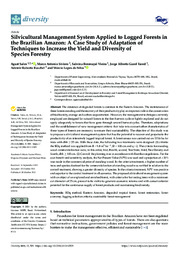Silvicultural management system applied to logged forests in the brazilian Amazon: a case study of adaptation of techniques to increase the yield and diversity of species forestry.
Silvicultural management system applied to logged forests in the brazilian Amazon: a case study of adaptation of techniques to increase the yield and diversity of species forestry.
Autoria: SALES, A.; SIVIERO, M. A.; VIEIRA, S. B.; YARED, J. A. G.; RUSCHEL, A. R.; SILVA, M. L. da
Resumo: The existence of degraded forests is common in the Eastern Amazon. The maintenance of these forests standing and the recovery of their productivity play an important role in the conservation of biodiversity, storage and carbon sequestration. However, the management techniques currently employed are designed for natural forests in the first harvest cycle or lightly explored and do not apply adequately to forests that have gone through several harvest cycles. Therefore, adaptations and the establishment of new management criteria that take into account other characteristics of these types of forests are necessary to ensure their sustainability. The objective of this study was to propose a silvicultural management system that has the potential to recover and perpetuate the productivity of an intensively logged tropical forest. A forest census was carried out on 535.6 ha for trees with dbh 25 cm. With these data, the following two treatments were designed: (1) criteria: the BDq method was applied from B = 9.8 m2 ha1, D = 100 cm and q = 2. The criteria for standing wood commercialization were, in this order, first, Health; second, Tree Stem; third, Tree Density and fourth, dbh 105 cm. (2) Control: the planning was in accordance with Brazilian regulations. For the cost?benefit and sensitivity analysis, the Net Present Value (NPV) was used and a projection of 20% was made in the commercial price of standing wood. In the criteria treatment, a higher number of trees and species destined for the commercialization of standing wood was verified in relation to the control treatment, showing a greater diversity of species. In the criteria treatment, NPV was positive and superior to the control treatment in all scenarios. The proposed silvicultural management system with an object of an explored and enriched forest, with criteria for harvesting trees with a minimum cut diameter of 25 cm, proved to be viable to generate economic returns and with conservationist potential for the continuous supply of forest products and maintaining biodiversity.
Ano de publicação: 2021
Tipo de publicação: Artigo de periódico
Unidade: Embrapa Amazônia Oriental
Palavras-chave: Amazonia, Forest management, Forest restoration, Sustainable forestry, Tropical forests
Observações
1 - Por padrão são exibidas publicações dos últimos 20 anos. Para encontrar publicações mais antigas, configure o filtro ano de publicação, colocando o ano a partir do qual você deseja encontrar publicações. O filtro está na coluna da esquerda na busca acima.
2 - Para ler algumas publicações da Embrapa (apenas as que estão em formato ePub), é necessário ter, no celular ou computador, um desses softwares gratuitos. Sistemas Android: Google Play Livros; IOS: iBooks; Windows e Linux: software Calibre.
Acesse outras publicações
Acesse a Base de Dados da Pesquisa Agropecuária (BDPA) para consultar o acervo completo das bibliotecas da Embrapa.

